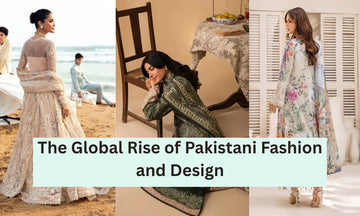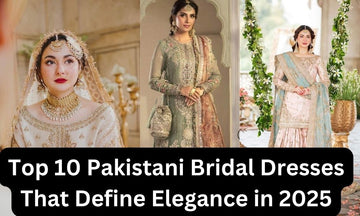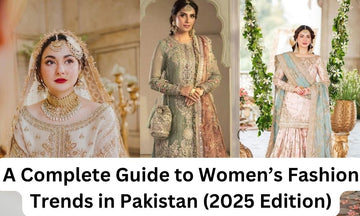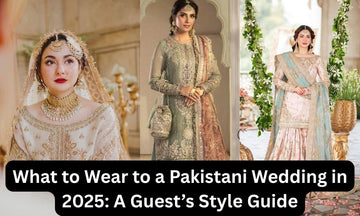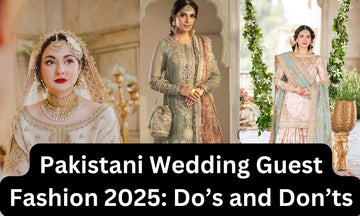Out from the borders of its nation, Pakistani fashion is sending waves around the world and earning the benefits of a leading force culturally. Colonised by centuries of traditions, shaped by elaborate techniques and aimed at being a future-oriented design, Pakistani fashion has become a powerful voice on the world scene today. This sector is expanding rapidly, represented by the success of both physical fashion shows and dynamic online markets. Pakistani fashion brands have gained international recognition for their craftsmanship, fusion of traditional and contemporary designs, and premium quality fabrics.
Blend of Tradition and Modernity
What is unique about the Pakistani fashion is its easy blend of historical components and modern aesthetics. Shalwar kameez and lehengas, the cultural clothes, are now shown in modern shapes, sharp patterns, and energised colour schemes. María B and Elan, or other artists, reimagine old designs with a modern feel for a watching public that applauds the marriage of our heritage and artistry. The process of amalgamating classic garments and contemporary polish without sacrificing authenticity is how Pakistani designers distinguish the fashion industry worldwide.
The Allure of Luxurious Fabrics
The superb fabrics that unite elegance and comfort are Pakistani fashion’s claim to fame. Lawn being a crisp cotton material has been gaining favor over as a summer essential in Pakistan and other hot zones of the world. Goods from Pakistan are well known for the comfort of silk, the luxury of velvet, and girls-motivation of chiffon. Such fabrics receive a high level of detail, which ensures both durability and elegance, which is why they are in high demand by international consumers pursuing both comfort and style.
From intricate embroidery to luxurious fabrics, a Pakistani boutique offers a wide range of handcrafted clothing that showcases the nation's rich cultural heritage.
Cultural Diversity and Global Appeal
Pakistani fashion has an eclectic tapestry where the elements of Punjab, Sindh, and Balochistan are mixed; each of the regions has its distinct artistic persuasion. Various areas have their fair share of unique touches, everything from the reflective Sindhi mirror work to Punjabi phulkari embroidery in colours. This cultural diversity speaks to individuals across the world, thus producing designs to capture a vast pool of clients. The artistry entwined with the design and colour scheme of Pakistani garments has effectively established an international name for the country as an artistic excellence.
The Lawn Revolution
Lawn beyond a textile constitutes a separate style. Lawn is a ground-breaking element in the Pakistani fashion industry. The lawn outfits, known for their airy feel and convenience, become even more attractive thanks to beautiful prints and elaborate embroidery and are the perfect choice for summer. Brands like Gul Ahmed & Al Karam have made lawn, which was once a day wear fabric, a high fashion statement, if not attire, as eagerly awaited annual collections are introduced. Cross-cultural demand for lawn outfits only underlines their timeless fashion and functionality.
Stay ahead of the trends with the latest Pakistani fashion, where contemporary styles merge seamlessly with traditional craftsmanship.
Craftsmanship: The Heart of Pakistani Fashion
The basis for Pakistani fashion is unparalleled skill and artistry. Every Pakistani design carries intricate embroidery, meticulous hand stitching and well-executed embellishments, both testifying to the generations-old skills of the artisanal producers. Some distinctive techniques of zari work, mirror work and thread embroidery are a unique attraction of Pakistani fashion. Probably because of this devotion to what is done by hand and who we are, Pakistani designs are vying across the world and elevating all attire to a wearable form of art.
Breaking Barriers Through Digital Platforms
Because of the internet and social media, fashion from Pakistan is no longer confined to Pakistani shores but is worldwide, having gained popularity. Thanks to social media networks such as Instagram and Facebook and e-commerce platforms, Pakistani brands can showcase their collections worldwide. Companies like Sana Safinaz and Khaadi have stepped up to the challenge, ensuring that their garments reach audiences everywhere in the world. The presence of virtual fashion shows and digital marketing strategies has hence given Pakistan a firm presence in the world of fashion.
Celebrity Endorsements and Global Recognition
Pakistani fashion has been given global exposure after collaborating with high-profile individuals and attending global occasions. Timothée Chalamet and Zayn Malik have been spotted wearing Rastah outfits, and high-quality Pakistani craftsmanship in the spotlight has been achieved thanks to designer Natasha Kamal and Milan Fashion Week collaborations. From supporting acts in venues such as Paris Fashion Week through to these achievements, Pakistani fashion has been featured in innovative and accessible designs. By merging historical techniques with forward-thinking design, Pakistani fashion can reach viewers from all around the world.
Sustainability and Ethical Practices
The growth of sustainable fashion has led many Pakistani labels to adopt eco-friendly practices in the way they produce goods. The use of environmentally friendly materials such as organic cotton and fair-trade labour programs reflects the global trend ethically. Sustainable sound design is being espoused by novel brands like Bareeze as they fuse sustainable materials with eternal style to attract more and more of the ecologically conscious population of the world.
Shopping for Pakistani clothes online offers the convenience of exploring intricate embroidery and luxurious fabrics from the comfort of your home.
Affordability Without Compromising Quality
The legitimisation of Pakistani fashion on the global level largely results from its distinctive capacity to offer top-class clothes at affordable prices. Pakistani brands ensure that all customers can find high-quality, genuine products with no limit to their budget, from intricately embroidered kurtas to glamorous three-piece sets. By offering exceptional quality at an affordable cost, Pakistani fashion has made it to the global market without diluting its cultural distinctiveness.
conclusion
The claim from marketplaces to world stages of Pakistani fashion fits well with its rich roots, inventive flair and global sweep. Pakistani clothing brands have become part of the global contextual fashion industry by successfully combining tradition and modernity, embracing the diversity of cultures and maintaining rigorous quality standards. No doubt in their constant travel towards, Pakistani fashion is bound to survive, appealing to the international audience with its lasting charm and national glory.
